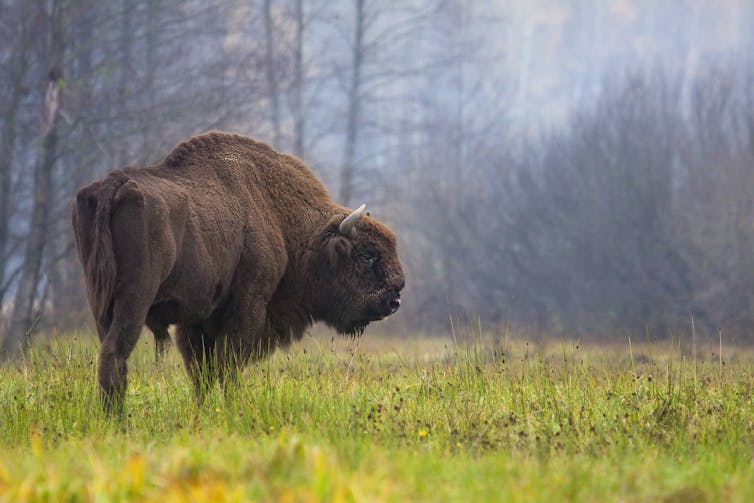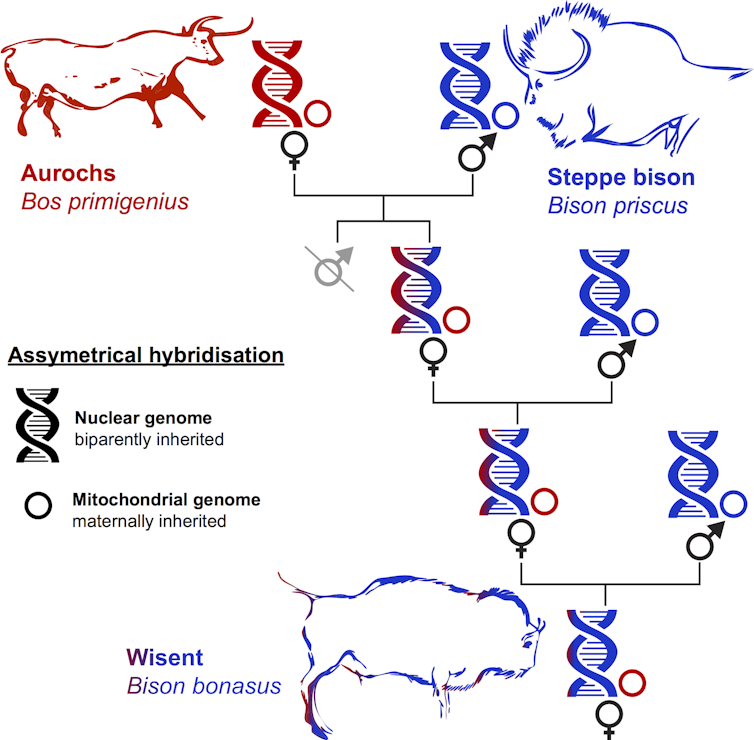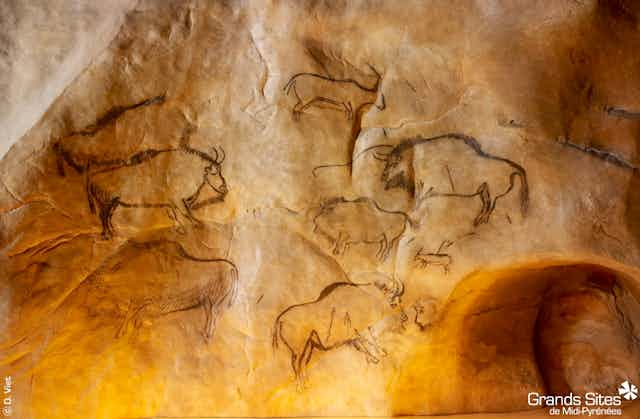More than 30,000 years ago, early cave artists in what is now southwestern France ventured deep underground into limestone caves, where they painted elaborate and detailed frescoes of the huge animals that dominated their lives. The accuracy of the depictions was remarkable – far better than most of us could manage crouched under a sloping damp wall under the flickering light cast by flaming bundles of vegetation and fat.
The paintings record a world of cave lions, mammoth, bison and horses, which we are only just beginning to unravel using the combined technologies of ancient DNA and radiocarbon dating. The results show that despite studying cave art for hundreds of years, we have been blind to some of the important stories the artists were telling.
Our research is a case in point. We have used ancient DNA from fossil bones to deduce the existence of a newly discovered bison species – only to discover that it was already recorded on the walls of caves across Europe, such as in Niaux Cave in southwestern France 17,000 years ago.
DNA detective story
In 1999, we began studying DNA from ancient bison bones found across the northern hemisphere, where Steppe bison had ranged from modern-day Britain to Mexico during the late Ice Age. Our aim was to study the impacts of climate change on animal populations, and sure enough we quickly found that in North America, populations of bison collapsed dramatically around the Last Glacial Maximum (between about 18,000 and 21,000 years ago).
This was well before humans arrived in North America, and it was the first clear demonstration of the key role played by climate change in the extinctions of bison, along with a range of other large species collectively known as “megafauna”.
We have since expanded this study into South America, to reveal that rapid warming events were the critical factor in the demise of many megafaunal species, often with an important finishing touch applied by human hunters.
In Europe, however, our early studies of ancient bison DNA were perplexing. By studying mitochondrial DNA, which is inherited exclusively through the maternal line, we realised that many of the bones were clearly not from Steppe bison, although this was the only species thought to have been in Europe before 10,000 years ago.
Instead, we realised we were looking at something novel: a species distantly related to today’s cattle and to the modern European bison, or wisent - which survives in a few protected forests in Europe, particularly Białowieża Forest between Poland and Belarus.

The little-known wisent is remarkable – the largest native species in Europe, but with a fossil record that goes back only 10,000 years. It almost became extinct after World War I following the collapse of hunting protections enforced by Polish and Russian royalty. Indeed, modern herds are descended from just 12 individuals, including one bull from the Caucasus, where the last wild wisent was shot in 1927.
Since the DNA from our ancient bones was neither Steppe bison nor wisent, we appeared to have found a new species - or had we? We started referring to it as the “Higgs bison”, because – just like the elusive Higgs boson which physicists spent decades tracking down – we had surmised the existence of something without knowing what it looked like.
On the trail
The first thing we needed to do was to confirm our mitochondrial DNA results with nuclear DNA, which is harder to retrieve from ancient bones but records all aspects of ancestry, rather than just maternal inheritance.
The nuclear DNA showed our Higgs bison was a hybrid – a cross between a female Aurochs, the extinct wild ancestor of modern cattle, and a male Steppe bison. We dated this hybridisation to more than 120,000 years ago.
Interestingly, this ancestry was the same for modern European bison, and even though the mitochondial DNA looked different (probably due to the recent population bottleneck), the Higgs bison was revealed as the ancestor of the wisent.
We still don’t know where or why the original hybridisation occurred, but recent breeding between polar bears and brown bears in response to climate-induced range contractions give us a clue that climate change might have been involved.
Male offspring of the Aurochs/Steppe bison union were sterile, as is common for mammal hybrids. As a result, several generations of females back-crossed with Steppe bison males (maybe even the same bull), resulting in a genetic ancestry of about 10% Aurochs and 90% Steppe bison.
After this initial interchange with the parental species, the Higgs bison went solo and never looked back - surviving the next 120,000 years, the arrival of modern humans, the megafaunal extinctions, World War I and the Communist revolution along the way. (If there ever needs to be an animal symbol of European history, we have a winner!).

But though we now knew that the Higgs bison went on to become the wisent, we hadn’t actually tracked down any more records of the Higgs bison itself. So we asked our colleagues in Europe whether anyone had noticed any strange bison in the records. Two groups said yes.
Dutch colleagues reported that among the many Steppe bison and Aurochs bones dredged from the North Sea they had noticed another, less common, smaller animal. Meanwhile, French cave art researchers replied that they had noticed that among the cave drawings were two distinct forms of bison: a wedge-shaped one with big horns, rather like a modern American bison; and a more evenly shaped animal with smaller horns, like a modern wisent.
This is where the story comes full circle. Radiocarbon dating of the artworks showed that the wedge-shaped form was drawn when Steppe bison were present on the landscape (around 18,000 years ago), while the small-horned version was drawn when our new species dominated Europe (after 17,000 years ago). Each species appears to have dominated Europe for long periods of time, alternating in response to major climate changes.
Overall, this investigation has thrown up many surprises. Apparently, mammals can form new species by hybridisation, even if only rarely. It also shows that despite the huge bison fossil record, and helpful drawings of both species displayed on cave walls, it took us until now to get the story straight.
How many other species are still hiding in plain sight, helpfully catalogued by prehistoric cave artists?

